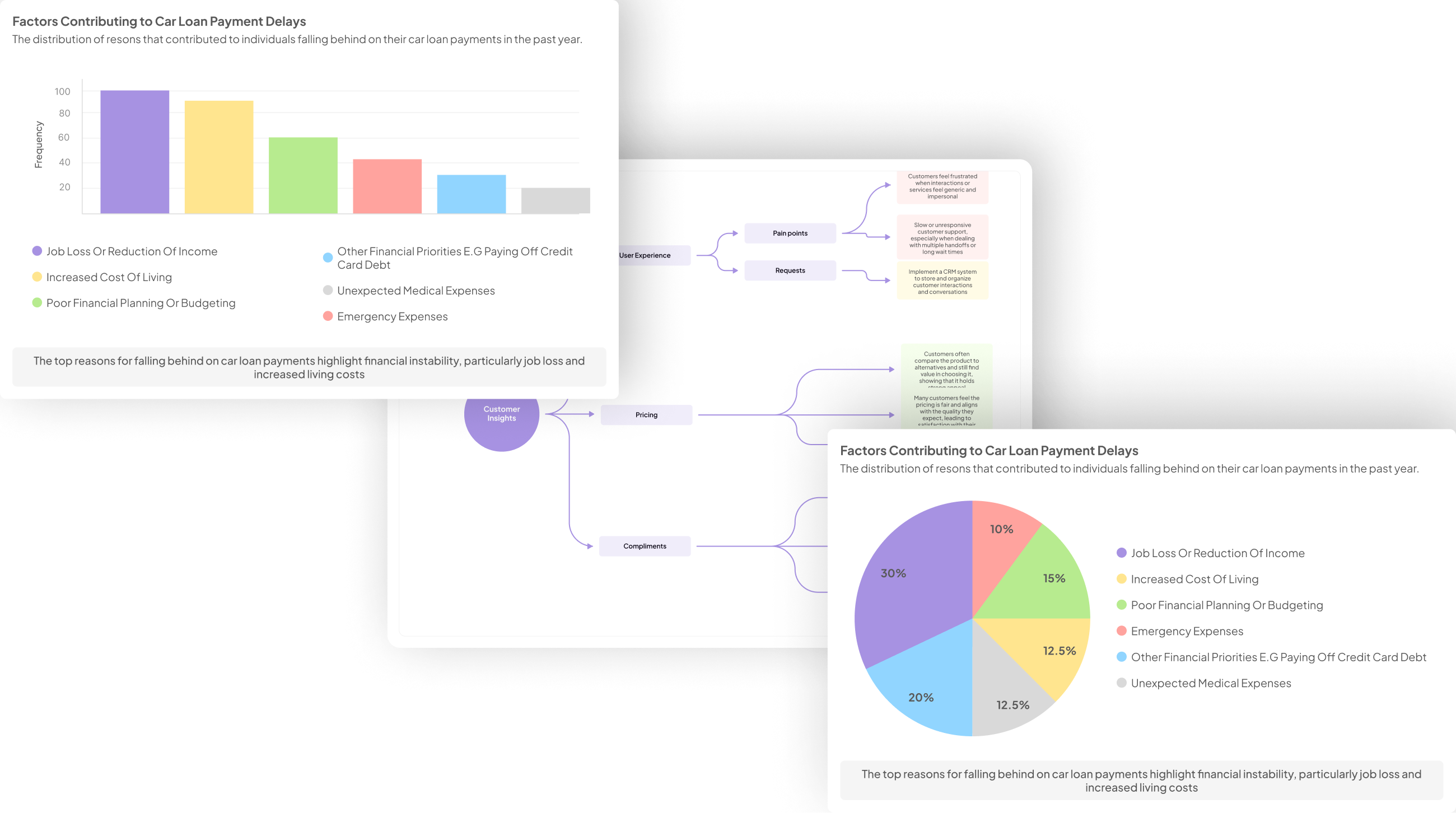Best AI tools for extracting insights from customer calls
-
Bella Williams
- 10 min read
Call Insights Extraction transforms the way businesses gain understanding from customer interactions. Imagine a sales team eager to fine-tune their approach, but struggling to make sense of countless customer calls. This is where advanced tools come into play, converting raw conversations into actionable insights. Not only do these tools streamline data analysis, but they also empower teams to identify trends, pain points, and opportunities from customer feedback.
The process of extracting insights from calls is crucial for informed decision-making. Customer calls contain rich, nuanced information that, when properly analyzed, can offer powerful perspectives on satisfaction and needs. By utilizing AI tools, businesses can efficiently sift through vast amounts of call data, unveiling essential insights that drive strategy and enhance customer experience.
Generate visualizations from your qualitative data. At Scale.

Understanding the Importance of Call Insights Extraction
Understanding the significance of Call Insights Extraction can transform customer interactions into actionable intelligence. Businesses engage in countless calls, each filled with valuable data that reflects customer sentiments, pain points, and preferences. By systematically extracting insights from these conversations, companies can identify trends and improve their offerings, ultimately boosting customer satisfaction.
Moreover, Call Insights Extraction not only informs strategy but also empowers teams to respond better. Companies can pinpoint recurring issues customers face, which aids in developing solutions tailored to address specific needs. Furthermore, these insights help create a better customer experience and foster loyalty over time. Embracing this process ensures organizations remain agile, adapting to market changes by continually integrating feedback from their most crucial asset: their customers. Understanding the importance of Call Insights Extraction lays the foundation for utilizing AI tools to drive customer-centric strategies.
Why Customer Calls Hold Valuable Data
Customer calls are a rich source of valuable data, providing insights that can significantly influence business strategies. These conversations often reveal customer needs, concerns, and preferences, offering a clear view into their thoughts. By extracting meaningful insights from calls, companies can understand product demand, identify service gaps, and enhance customer interactions.
Through call insights extraction, organizations gain the ability to analyze customer feedback systematically. This process allows for a deeper understanding of customer sentiment, enabling businesses to tailor their offerings to meet specific needs. Furthermore, understanding the types of inquiries made during calls can help sales teams craft targeted upselling strategies. Ultimately, leveraging this data transforms customer interactions into actionable insights, paving the way for informed decision-making and improved service delivery.
Key Challenges in Extracting Insights from Calls
Extracting insights from calls presents several key challenges that organizations must overcome. One major hurdle is the variability in call quality, which can affect the accuracy of transcriptions. Background noise, overlapping dialogue, and different accents can distort the valuable information hidden within conversations. Furthermore, the sheer volume of calls can make it difficult to analyze and identify critical patterns effectively.
Another challenge lies in the ambiguity of human communication. Emotions, tone, and context often influence customer sentiments, complicating the extraction process. Without nuanced understanding, insights might be misinterpreted or overlooked entirely. Additionally, data privacy regulations must be carefully navigated to ensure compliance when analyzing recorded calls. Organizations must adopt robust strategies to tackle these challenges for successful call insights extraction, ultimately leading to better decision-making and improved customer experiences.
Call Insights Extraction is a critical area for businesses looking to enhance their customer interactions. By analyzing customer calls, organizations can reveal patterns, concerns, and sentiments that inform service improvements and strategy adjustments. The insights derived from these conversations not only help in understanding customer needs but also improve team performance.
However, several challenges arise when extracting meaningful insights from calls. Agents often face difficulties in communicating effectively, leading to misunderstandings that delay resolutions. Moreover, distinguishing customer dissatisfaction due to agent performance from issues outside their control can complicate the analysis. This blend of challenges underlines the necessity of effective AI tools. Using advanced technology allows businesses to automate the analysis process, providing deeper insights while minimizing manual efforts. With the right approaches, customer calls can become a goldmine of actionable data that drives growth and satisfaction.
Evaluate Performance on Customer Calls for Quality Assurance.
Top AI Tools for Call Insights Extraction
When considering the top AI tools for call insights extraction, it's essential to recognize their significant role in analyzing customer interactions. These tools streamline the process of extracting meaningful information from conversations, allowing businesses to make data-driven decisions. Notably, efficient transcription capabilities enable users to convert recorded calls into text, making it easier to dissect and analyze customer feedback.
Key tools to explore include solutions like CallMiner, which excels in sentiment analysis, and Chorus.ai, which focuses on improving sales conversations through AI insights. Gong.io offers a comprehensive understanding of customer needs by providing valuable correlations between sales data and customer sentiment. Lastly, CallTrackingMetrics presents a robust platform for tracking and analyzing customer interactions efficiently. By integrating these AI tools into your workflow, organizations can significantly enhance their understanding of customer behavior and preferences, empowering them to refine their strategies.
insight7: Leading the Way in Customer Call Analysis
In today’s competitive market, effective customer call analysis is crucial for businesses aiming to enhance customer satisfaction and improve service delivery. Organizations face a unique challenge: extracting meaningful insights from vast amounts of customer interactions. By focusing on call insights extraction, companies can transform these conversations into actionable data, leading to better decision-making and strategic advantage.
One of the primary obstacles is the sheer volume of information generated by customer calls. Traditional methods often fall short, making it difficult to identify trends and actionable insights quickly. As a solution, modern AI-powered tools streamline this process, enabling businesses to efficiently process and analyze calls. These tools not only save time but also enhance collaboration by consolidating insights into a single, accessible platform. By embracing call insights extraction, companies can engage more effectively with their customers and stay ahead in a rapidly evolving marketplace.
The Power of CallMiner for Transcription and Sentiment Analysis
Call Insights Extraction relies significantly on effective transcription and sentiment analysis capabilities. This solution allows businesses to stream and transcribe customer calls easily, generating transcripts that become a valuable resource for analysis. First, the software can transcribe multiple audio files quickly, enabling teams to process conversations at scale efficiently. Users can drag and drop files and receive instant transcripts, making the initial step towards understanding customer sentiments straightforward.
Once the calls are transcribed, the real power of sentiment analysis shines through. Businesses can extract actionable insights, identify customer pain points, and monitor trends in customer feedback. By analyzing the emotions expressed during calls, organizations can enhance their service and tailor their offerings more precisely to customer needs. This dual capability of transcription and sentiment analysis makes it a compelling choice for any organization wishing to derive meaningful insights from customer interactions.
Chorus.ai: Enhancing Sales Conversations with AI Insights
Sales conversations can be significantly enhanced through the effective extraction of call insights. By utilizing advanced AI technologies, businesses can analyze customer interactions more efficiently, leading to better understanding and monitoring of sales performance. This method streamlines the process of identifying crucial themes, pain points, and customer needs that arise during those calls, making it an essential component of modern sales strategies.
The ability to transcribe and analyze calls at scale provides organizations with actionable insights, enabling them to interpret customer feedback and improve their sales approach. The AI tool in question allows users to easily upload audio files, transcribe them, and extract insights with just a few clicks. Moreover, it offers templates for various types of analysis, such as understanding the voice of the customer. This systematic approach not only saves time but also empowers teams with the meaningful information needed for informed decision-making.
Gong.io: A Comprehensive Approach to Understanding Customer Needs
The process of extracting call insights begins by carefully analyzing customer interactions. This aids organizations in understanding their customers' specific needs and preferences better. Using advanced technology, businesses can transcribe calls into readable text, enabling a deeper analysis of relevant conversations. This not only enhances the overall quality of customer service but also provides insights that help align products with market demands.
Through an organized method of analyzing call data, companies can categorize feedback, uncover patterns, and generate actionable reports. By implementing tailored dashboards, organizations have the power to visualize insights, making them readily accessible to teams. This comprehensive approach not only improves call quality but also fosters a culture of consultative selling. Consequently, businesses can transition from merely fulfilling orders to becoming trusted advisors for their customers, ultimately leading to increased customer satisfaction and loyalty.
CallTrackingMetrics: Tracking and Analyzing Customer Interactions
Tracking and analyzing customer interactions is crucial for understanding the nuances of consumer preferences and behaviors. By effectively monitoring calls, businesses can glean valuable insights that inform product development, marketing strategies, and customer service improvements. Using AI tools, companies can automate this process and derive actionable data, enhancing their ability to meet customer needs.
The journey of call insights extraction begins with comprehensive call tracking, enabling the identification of common customer queries and concerns. This data can then be compiled into reports that highlight trends, which are essential for continuous improvement. Ultimately, the use of advanced AI technologies transforms raw call data into strategic insights, allowing businesses to adapt and evolve in response to customer feedback. Implementing these insights leads to a more informed approach in enhancing customer experience and driving business growth.
Steps for Implementing AI Tools in Call Insights Extraction
Implementing AI tools for call insights extraction begins with identifying clear objectives and key performance indicators (KPIs). Defining what you want to achieve helps ensure that the data collected is relevant and actionable. Determine factors like customer satisfaction, response times, or resolution rates to provide a framework for measuring success.
Next, selecting the right AI tool tailored to your unique business needs is crucial. Each tool has its capabilities, such as transcription accuracy or sentiment analysis, that can significantly impact your insights. Once a tool is chosen, integrating it with existing systems and providing staff training are essential for seamless implementation. This enables all users to maximize the tool’s potential in extracting meaningful insights. Lastly, establishing a process for measuring success will help in refining strategies over time, ensuring ongoing improvement in call insights extraction.
Step-by-Step Guide to Deployment
Deploying effective AI tools for Call Insights Extraction requires a structured approach. Start by identifying specific objectives and key performance indicators (KPIs) tailored to your business needs. This clarity will help guide your selection of an appropriate AI tool, ensuring it aligns with your goals.
Next, carefully choose the right AI tool for your organization, considering factors such as usability and integration capabilities. After purchasing, invest time in integrating the AI tool with your existing systems. It’s crucial to provide comprehensive training for your team, as this empowers them to effectively utilize the tool.
Lastly, establish metrics for measuring success. Regularly assess the impact of the insights generated and refine the processes to ensure continuous improvement. By following these steps, you will streamline the deployment of AI tools and unlock deeper insights from your customer calls.
Step 1: Identifying Objectives and KPIs for Call Insights Extraction
Identifying objectives and key performance indicators (KPIs) is essential for effective Call Insights Extraction. Start by defining what you aim to achieve with the data. Are you focused on improving customer satisfaction, enhancing sales strategies, or identifying product issues? Clear objectives will guide your analysis and ensure that your efforts align with business goals.
Next, establish specific KPIs to measure the success of your call insights initiatives. Common KPIs include customer satisfaction scores, average handling time, and conversion rates. These metrics will help you evaluate the impact of insights on your business. By pinpointing objectives and KPIs, you create a solid foundation for extracting actionable insights from customer calls, ultimately leading to enhanced decision-making and improved overall performance. Remember, clarity in your goals will pave the way for successful AI integration in your call analysis process.
Step 2: Selecting the Right AI Tool for Your Business Needs
Selecting the right AI tool for your business needs is a crucial step in effective call insights extraction. Start by identifying your unique objectives. Consider the specific insights you wish to gain from customer calls, such as understanding customer sentiment or improving training for your team. Your objectives will shape the features you require from an AI tool, ensuring that it aligns well with your goals.
Next, evaluate potential tools based on their functionalities. Look for features like transcription accuracy, sentiment analysis, and data reporting capabilities. It’s vital to choose a tool that not only meets your current needs but also adapts as your business evolves. Finally, consider data privacy and compliance, as these are paramount when handling customer information. By taking the time to assess these factors, you can effectively select an AI tool that enhances your ability to extract valuable insights from customer calls.
Step 3: Integrating with Existing Systems and Training
Integrating AI tools for Call Insights Extraction into existing systems is crucial for maximizing their effectiveness. First, assess your current software environment. This evaluation will help you understand compatibility and identify any gaps needing resolution. Connecting AI tools with customer relationship management (CRM) systems and training platforms can streamline processes. This integration allows for seamless sharing of insights, ultimately enhancing customer interaction quality.
Training is a fundamental aspect of this step. Equip your team with the knowledge to effectively utilize these tools. Offer workshops that focus on interpreting the insights generated from customer calls. This ensures that employees are not only familiar with the technologies but are also prepared to apply the newly acquired insights in real-world scenarios. Such proactive measures can lead to improved outcomes and deeper customer relationships as your team becomes adept at responding to customer needs.
Step 4: Measuring Success and Making Continuous Improvements
To effectively measure success and foster continuous improvements in Call Insights Extraction, businesses must establish clear metrics. Start by defining what success looks like in your specific context, such as increased customer satisfaction, improved training outcomes, or enhanced sales performance. By setting these benchmarks, stakeholders can gauge the effectiveness of AI tools in extracting valuable insights from customer calls.
Next, regularly review and analyze the data collected. This analysis will highlight trends, successes, and areas that need adjustment. Conducting feedback sessions with your team can also offer qualitative insights that data alone can't capture. Incorporating these insights into the training of customer service representatives ensures that evolving customer needs are addressed efficiently. Additionally, maintaining an agile approach to AI tools allows businesses to adapt to changing dynamics in customer interactions effectively. These strategies ensure that the insights extracted from customer calls contribute to ongoing success and improvement in your operations.
Conclusion: The Future of AI-Powered Call Insights Extraction
AI-powered call insights extraction is rapidly evolving, driven by advancements in machine learning and natural language processing. As businesses recognize the value of customer conversations, they are increasingly utilizing AI tools to transform these interactions into actionable insights. Future developments promise enhanced accuracy and speed, allowing companies to dissect large volumes of data effortlessly and with greater precision.
Looking ahead, the integration of AI in call insights extraction will likely lead to more personalized customer experiences. By automating the identification of key themes and pain points, organizations can proactively address customer needs and improve overall satisfaction. This evolution not only streamlines processes but also empowers teams to make data-driven decisions that foster growth and innovation in the ever-competitive market.







